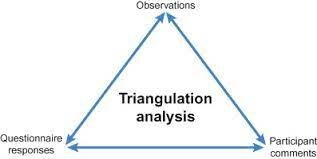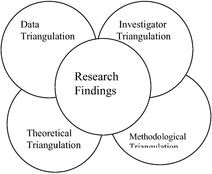Triangulation
is a technique that validates the data by using two or more sources. It
produces an understanding under inquiry through various means. In a research
study, triangulation plays an important role in producing a finding by valid and reliable data for increasing the chances of authentic findings
(Honorene, 2017).
According
to Heale and Forbes (2013), triangulation is applying more than one way to
carry out the data collection in order to investigate a research problem. It
increases the confidence to find results providing a true picture of the social
phenomenon being studied. It includes various methods, sources of data
collection, or investigation of a single phenomenon to be studied.
Qualitative researchers use a variety of triangulation in their studies to improve the quality of the research. First, data triangulation of time, space, and participants analyzing data at multiple levels namely aggregate, interactive, and collectivity. Through triangulation of data from various sources, the researchers take advantage of several actual situations to form a base for their observation. The second one is methodological triangulation which means applying different methods for the purpose of making the research process flexible within the research study.
Third, perspective triangulation is the form in which the researchers compare the participants’ perspectives with parallel theoretical systems for the purpose of using multiple perspectives to investigate the research problem. It is carried out to form a perspective that proves to be true at the participants’ level in compliance with determined sociological rules related to the theory to be established. Forth one is investigator triangulation which is engaging the various observers for securing many different points of view regarding the actions concerning research questions (Roulston, 2018).
According
to Heale and Forbes (2013), the three major consequences of applying different
triangulation approaches are found namely convergence, inconsistency, and
contradiction in qualitative research studies. Convergence is about the data
from multiple sources, methods, investigators which will provide evidence for a
result in a single proposition regarding the social phenomenon being studied.
Inconsistency concerns generating different perspectives from different sources,
methods, investigators who do not corroborate a single proposition regarding
the social phenomenon under study. As well as contradiction is the result of
unlike views of the social phenomenon from different methods.
In a qualitative research study, if convergence is not evidenced on a single explanation while inconsistency or contradiction is found from the data then the researchers make their meaning of what they found. The focus in triangulation changes from technological solutions to ensure validity to researchers’ discretion to form a plausible explanation of the phenomenon under investigation. The researchers need to predetermine the limitations and significance of their selected methods while applying the qualitative design in their studies. they need to know what quality means to them while conducting the research study through the concerned design for their research study.
Because the nature of quality differs for ethnography, narrative studies, and
case studies. The definition of quality to be ensured in one design will be
problematic for the researchers using different designs. The results of triangulation
as a strategy to improve the quality in one study on which the researchers
reach an informed decision but the results of triangulation in another study
may or may not be the same. It depends on the meaning of quality in one research
design which is differed in meaning in another design (Roulston, 2018).
Honorene (2017) summarized that triangulation helps in improving the quality of qualitative research as multiple sources of gathering data provide an ample chance for meaningful insights into the research problem. Shortfalls in one source of data can be reduced by applying various sources which confirm the same data. It is more logical that a number of sources verify and validate the findings of research while harmonizing similar data.
By using the triangulation procedures the data in a qualitative research
study obtained may be more comprehensive. Employing multiple ways for data
collection supports making it convenient for the researchers to analyze
data followed by reaching valid results and ending. Similarly, the
discrepancies in collected data are easily predicted and meanings are drawn
from such inconsistencies by using a variety of sources in triangulation
procedures.
Conclusion
The quality of qualitative research
studies is improved through triangulation which is relevant according to
the selected design to investigate any social phenomenon. Applying various
forms of triangulation such as data triangulation, methodological
triangulation, perspective triangulation, and investigator triangulation
supports the qualitative researchers improve the quality of their research
studies. Convergence, inconsistency, and contradictions are the outcomes of the
triangulation on which the researcher draws their results. The confirmation of
data from multiple sources increases the chances of high validity of the
findings and results of a qualitative research study.


